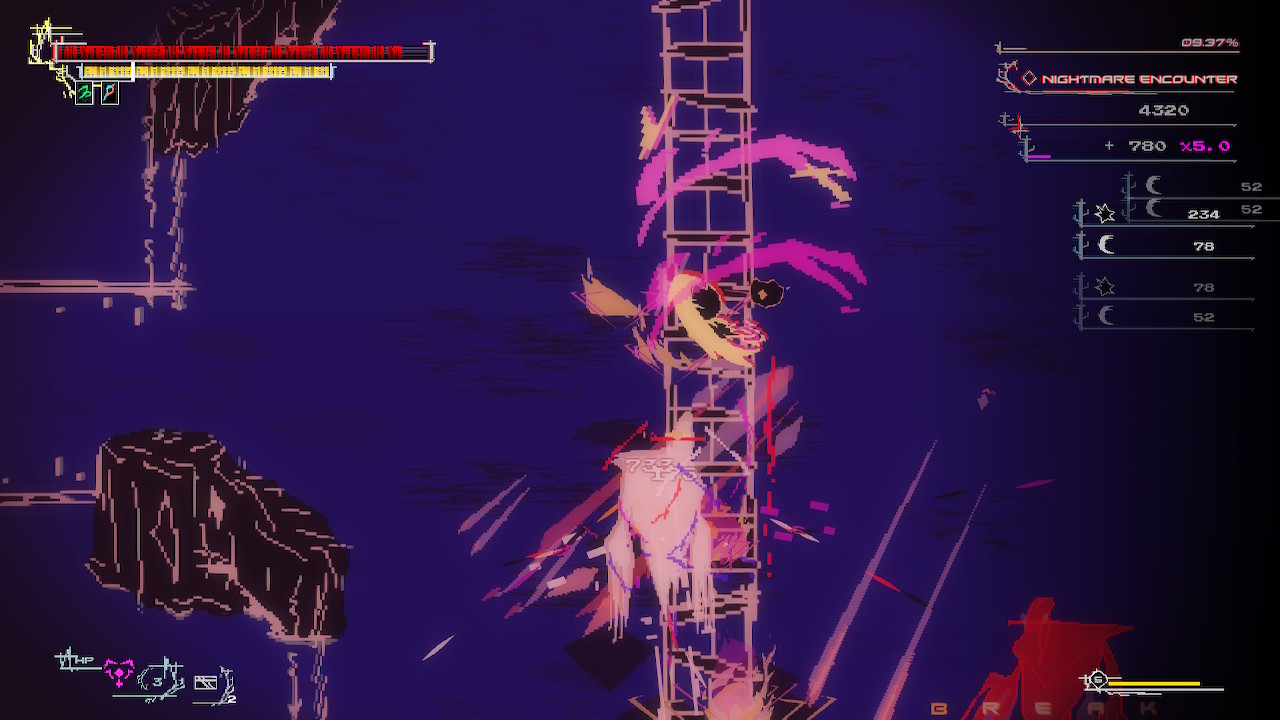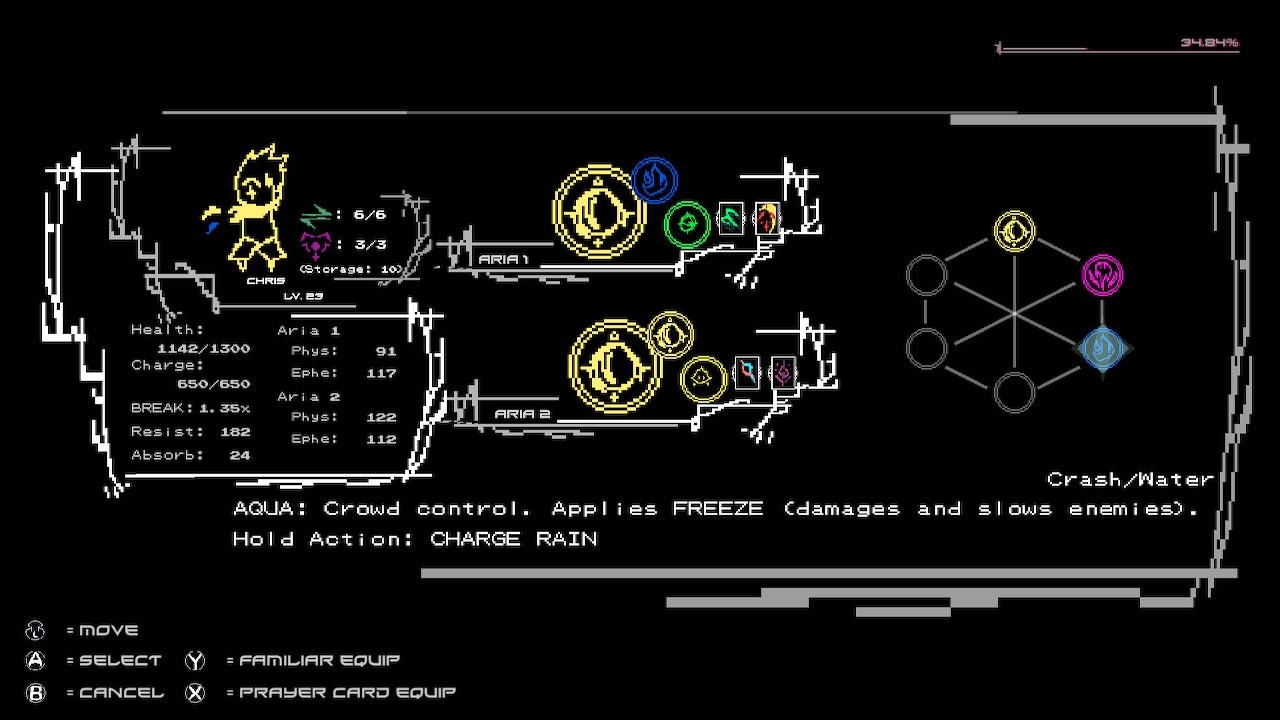[Review] Death of a Wish
System: Switch
Release date: March 11, 2024
Developer: melessthanthree
Publisher: melessthanthree
As I journeyed across the nightmarish, apocalyptic world of Death of a Wish, slaughtering through the countless waves of monstrosities that crossed protagonist Christian’s path, my journey to help him hunt down the forces that had decimated this place became a substantially more mysterious one than I had expected initially. This may be a combat-action game through and through, but beyond its narrow and polished gameplay focus lies a narrative web of opposing forces that’s just as compelling to untangle, even when the power of its relentlessly brooding atmosphere begins to fade. Death of a Wish is tightly-designed, fiendish action experience that rewards players who fully engage with its mechanics and world building, and despite some missed opportunities here and there, I enjoyed the time I spent with it.
Death of a Wish is the second game from developer melessthanthree, and appears to be a direct follow-up to its previous title, Lucah: Born of a Dream. Generally, when I’m reviewing a game from a studio I’m unfamiliar with, I try and make a point to at least familiarize myself with some of their previous work so I can be more fully-informed when approaching a game from a critical lens. And while I didn’t play Lucah myself prior to playing Death of a Wish, even at a cursory glance it’s clear that the games share a lot of common DNA. The visuals, combat system, and even the HUD of Lucah seem to have been adapted to this game very precisely, and I even noticed some recurring locations and characters. I mention this from the outset because I think that players who enjoyed Lucah will probably enjoy a lot of the same things about Death of a Wish, and those who didn’t will likely be put off those shared similarities. For me, I started Death of a Wish almost completely blind, and enjoyed the game as a standalone experience without having played Lucah.

Our protagonist, Christian, is a hot-headed soul who’s wandering through the warped and twisted world of Neo-Sanctum. At the start of the game, there are a lot of questions about what the nature of this place really is and why it’s crawling with violent creatures called Nightmares, but it’s clear that Christian’s mere presence in this place is unwelcome. His mission is to hunt down the four Faiths – Father, Sister, Cardinal and Priest – powerful spiritual forces who have imposed violence and misery into this world. The game positions these religious symbols as leaders of what Christian views as a violent cult – one that also raised him, and took someone important from him. His journey to wreak havoc on these forces takes him across a maze-like world, where he’ll mow down hundreds of fast, dangerous beasts, along with anyone else who interferes with his journey for justice.
Death of a Wish is first and foremost a melee-focused combat game, one that’s hyper-focused on pushing the player to understand its mechanics as deeply and fully as possible. It does this through its scoring system, which grades the player after each combat encounter based on how long it took to clear it, whether damage was taken, and how effectively the player utilized their moveset. Many other combat-action games have implemented this type of system – most famously the Devil May Cry series – but in Death of a Wish, ignoring it could have serious repercussions. This is because Christian has been Marked – cursed, if you will – and every fight he enters will slowly, inevitably fill the Corruption meter that looms over the player throughout the game. If Christian dies in battle, the Corruption meter will fill even more. What happens when the meter reaches 100% is something the game doesn’t reveal, but it does warn the player that it won’t be good. The only way to counteract it is by fighting with style and speed – get an S rank in combat, for example, and Christian’s corruption could lower by as much as three percentage points. It’s a really well designed system that adds tension to each combat encounter, and really encouraged me to try and learn the intricacies of battle.

Christian’s core moveset is familiar and not particularly exciting – a standard mix of light, heavy, and recharging ranged attacks are his primary offensive tools – but it benefits from a high degree of customizability that has tangible gameplay benefits. Christian’s base attacks have several different variants that fluctuate depending on which Aria he has equipped. Arias have different types of damage they dish out that are more effective against certain types of enemies, like Slash and Holy. The power of each Aria is also at least somewhat dictated by how the player chooses to invest skill points when leveling up, a process that also impacts things like Christian’s health, for example. It’s a little dense to understand initially, and the reality is that players who don’t care to fully understand all the terminology will still be able to have a great time simply by dumping skill points wherever they feel is best. That said, there’s some real room to build a playstyle based around what elements of combat might feel most rewarding. In fact, Christian can actually have two sets of Arias equipped at a time that he can swap between in the heat of battle, and this becomes especially fun to utilize in the back half of the game once encounters get more complex.
Other elements of combat can be customized too – Christian can change which type of ranged attacks he can fire off, and also equip modifiers called Prayer Cards to each Aria. Then there are Virtue Crads, which act as more general perks that can grant Christian new abilities, such as slowing down time during a perfect parry. The player can increase the amount of Virtues Christian can have equipped by buying or finding an upgrade item called a Rosary, and I enjoyed trying to get my hands on as many of these as I could simply because I was having fun trying to max out my combat capabilities.
Death of a Wish places a particularly big focus on parrying, and it’s really satisfying to pull off. Enemies will take more damage once their defenses are broken down, and while certain playstyles will accommodate utilizing brute strength or frantic volleys of attacks, I really enjoyed the cadence of parrying as it has both offensive and defensive benefits. Parrying enough times will help break an enemy’s guard quickly, entering them into a temporary defenseless state where they’ll take extra damage. It’s a constant goal to work towards in each battle, and the excellent punchy sound design and tension-building synth soundtrack helps make these moments stand out even more.

There’s much more at play in the combat system then I can reasonably summarize here, including a Taunt mechanic, additional customization for Arias, combos and more. It can be a lot to get a grasp on, but fortunately, Death of a Wish has a very flexible approach to difficulty, essentially giving the player full control to tweak it at any time in a few different ways. The game also includes built-in cheats to further weaken enemies, grant Christian extra health, and more. You also have a limited number of rewinds that you can utilize to retry a fight if you realize mid-battle things aren’t going in your favor. I think the overall difficulty curve is well-balanced, and all of these factors together result in a game that can be enjoyed by anyone interested in the genre.
As I navigated the unsettling, beautiful scribbled-nightmare world of Neo Sanctum, I often found myself wandering into decrepit spaces that hinted at the story of what happened in this crumbling place. I became excited to learn more about the ongoing power struggle happening in this strange city, and Christian’s conversations with the various characters he meets along his journey not only help contextualize a lot of the mystery, but also satisfyingly unravel into one another as it becomes increasingly apparent to just how everyone’s connected. It’s strange, because it wasn’t their personalities that resonated with me as much as their collective wisdom. There’s a sense while playing Death of a Wish that everyone in this world knows more than you, that there’s much more complexity to this whole violent crusade you’re trying to stop, and that this world has some secrets that are intentionally being obfuscated. While Death of a Wish keeps the true nature of its story well-hidden up until the penultimate chapters of the game, and occasionally borders on being a little too vague for its own good, the overall themes remained an engaging motivating throughline. There’s also a great twist towards the end of the experience that shakes thing up – both narratively and mechanically – in a very bold way that I really enjoyed.
Death of a Wish’s strong vision is amplified further by its singular visual presentation, with art that – and I mean this as a compliment – looks like it was drawn by a child in serious need of an exorcism. From the scenery to the characters, everything is drawn in this pencil-sketchbook style, and the generally dark environments really allow objects in the world to pop. There’s not really a lot of visual variety to the setting – despite some different architecture and foliage, each region I explored didn’t feel notably distinct from the last – but generally I was so focused on the action itself that it didn’t bother me. That being said, I do wish there was more to do in Death of a Wish beyond the combat. I would have liked to see traversing through the world be made more interesting, perhaps through some sort of environmental puzzles or timing-based navigation challenges, but as it is now, Neo-Sanctum exists almost solely as a backdrop for violence. Which is a shame, because I really wanted to engage with this strange and twisted place beyond that surface level.
The Verdict

Death of a Wish is a challenging but rewarding action-driven experience that stands out thanks to its highly customizable combat system, its moody and mysterious nightmare-world setting, and its beautiful yet unsettling visuals and audio. While its premise is heavy on religious themes and vague terminology that can make its narrative beats a little tough to keep up with, this also contributes to a delightfully mysterious vibe where I always felt just like the outsider the game posits Christian as. Some extra visual and mechanical variety would have helped cement the world of Neo-Sanctum as a more tangible place to explore, but I was having so much fun with the frenetic, high-stakes battles that I couldn’t help but get sucked in anyways. Players who are open-minded to an alternative take on the combat-action genre will likely find a lot to love in Death of a Wish.
Death of a Wish copy provided by the publisher for the purposes of this review.
